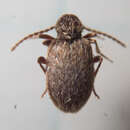pt-BR
nomes no trilho de navegação


Der Australische Diebkäfer (Ptinus tectus) ist ein Käfer aus der Unterfamilie der Diebskäfer (Ptininae).
Der Australische Diebkäfer wird etwa drei bis 3,5 Millimeter lang und besitzt eine matte, dunkelbraune Grundfärbung. Die Behaarung ist goldbraun bis gräulich weiß und liegt eng am Körper an. Die Borstenhaare auf den Flügeldecken sind aufgereiht und stehen ab. Die Halsschildbasis ist beiderseits mit einem Haarpolster und zwei kleinen stumpfen Höckern versehen. Geschlechtsdimorphismus wird bei dieser Art nicht beobachtet.
Die Larven erreichen eine Länge von etwa fünf Millimetern und sind weiß bis gelblich und mit einer feinen, abstehenden Behaarung versehen. Die Kopfkapsel ist gelbbraun.
Der Australische Diebkäfer ist ursprünglich in Australien, Neuseeland und Tasmanien beheimatet. Er wurde um 1900 über England nach Europa eingeschleppt. Man findet ihn sowohl in der freien Natur, wo er hauptsächlich in Vogelnestern von Tauben, Schwalben, Sperlingen oder in blühenden Koniferen lebt, als auch in Vorräten.
Unter optimalen Bedingungen (23 bis 25 °C; 70 bis 90 % Luftfeuchtigkeit) produzieren die Weibchen des Australischen Diebkäfers mehrere hundert Eier, die unmittelbar auf das Fraßsubstrat abgelegt werden. Die Larven schlüpfen nach etwa 14 Tagen. Die weitere Entwicklung verläuft über drei bis fünf Larvalstadien und dauert in Abhängigkeit von der Temperatur und dem Nahrungsangebot vier bis acht Wochen.[2] Die Larven zeichnen sich durch eine ausgeprägte Spinntätigkeit aus. Zur Verpuppung bohren sie sich beispielsweise in Leder, Kunststoffe, Verpackungen, Papier oder Pappe ein und legen dort ihre Puppenwiege an.
Die Imagines sind lichtscheu und nachtaktiv aber nicht flugfähig. Sie fressen an Leder, Textilien und in Museen auch an tierischen Präparaten und schädigen diese durch Oberflächenfraß. Die Käfer sind an Trockenheit gut angepasst. Die Lebensdauer beträgt unter günstigen Bedingungen zehn bis zwölf Monate, normalerweise aber nur zwei bis drei Monate. Im Jahresverlauf entstehen zwei bis drei Generationen.
Der Käfer ist ein in Mitteleuropa weit verbreiteter Schädling, der in verschiedenen tierischen und pflanzlichen Vorräten wie beispielsweise Gewürzen, Tee, getrockneten Früchten, Malz, Hefe, Grieß, Vogel- und Fischfutter und Fischmehl anzutreffen ist. An Getreideprodukten findet man ihn erst nach Vorschädigung durch andere Schädlinge.
Der Australische Diebkäfer (Ptinus tectus) ist ein Käfer aus der Unterfamilie der Diebskäfer (Ptininae).
Ptinus tectus, often called the Australian spider beetle, is a species of beetle in the family Ptinidae,[1] or family Anobiidae, subfamily Ptininae.[2] It is a cosmopolitan species (arrived in Europe and the UK from Australia in 1900). It is a pest of stored foods and museum specimens.
P. tectus Boieldieu, 1856 is the name most often used for this species. Some works still state Ptinus ocellus Brown, 1929.[3]
The Australian spider beetle (Pictus tectus) measures 2.5–4 mm in length and is coloured dark brown. The adults have biting mouthparts, a well developed thorax and 11-segmented antennae. Characteristics which give them a spider-like appearance include a stout body, pronounced constriction of the neck shield and 6 long thin legs with 5-segmented tarsi.[4]
The female Australian spider beetle lays 100–120 sticky eggs over a period of 4–5 weeks in early summer, either singly or in small batches. At 20–25 °C the eggs hatch in 3–16 days, producing larvae which are fleshy, curved, covered with fine hairs and relatively immobile. Larval development takes at least 6 weeks, during which time the larvae moult 4 or 5 times. When mature, they wander in search of a pupation site where they spin a cocoon cell in which to pupate. Adults emerge after 20 to 30 days and will live for as long 12 months.[4]
At 70% R.H. development of Ptinus tectus from egg laying to emergence from the cocoon takes an average of about 62 days at 23–25 °C; at 15 °C the time taken is about 130 days. The minimum temperature at which complete development can occur is 10 °C and the maximum is between 28 and 30 °C. Considerable mortality occurs in eggs and larvae at 28 °C.[5]
The species is considered as a pest in museums.[6] It is recorded from at least 55 museums and historic houses in the United Kingdom.[7]
Ptinus tectus, often called the Australian spider beetle, is a species of beetle in the family Ptinidae, or family Anobiidae, subfamily Ptininae. It is a cosmopolitan species (arrived in Europe and the UK from Australia in 1900). It is a pest of stored foods and museum specimens.
P. tectus Boieldieu, 1856 is the name most often used for this species. Some works still state Ptinus ocellus Brown, 1929.
Ptinus tectus is een keversoort uit de familie diefkevers (Ptinidae). De wetenschappelijke naam van de soort is voor het eerst geldig gepubliceerd in 1856 door Boieldieu.[1]
Bronnen, noten en/of referentiesPtinus tectus é uma espécie de insetos coleópteros polífagos pertencente à família Anobiidae.[1]
A autoridade científica da espécie é Boieldieu, tendo sido descrita no ano de 1856.
Trata-se de uma espécie presente no território português.
Ptinus tectus é uma espécie de insetos coleópteros polífagos pertencente à família Anobiidae.
A autoridade científica da espécie é Boieldieu, tendo sido descrita no ano de 1856.
Trata-se de uma espécie presente no território português.
Bọ cánh cứng nhện Úc, tên khoa học Ptinus tectus, là một loài bọ cánh cứng thuộc chi Ptinus trong họ Anobiidae.[1][2][3]
Chúng là một loài bọ cánh cứng nhỏ phá hoại nhiều loại sản phảm. Nó là loài bọ trong nhà phổ biến nhất. Loài này đến châu Âu và Anh quốc từ Úc vào năm 1900.
Bọ cánh cứng nhện Úc, tên khoa học Ptinus tectus, là một loài bọ cánh cứng thuộc chi Ptinus trong họ Anobiidae.
Chúng là một loài bọ cánh cứng nhỏ phá hoại nhiều loại sản phảm. Nó là loài bọ trong nhà phổ biến nhất. Loài này đến châu Âu và Anh quốc từ Úc vào năm 1900.